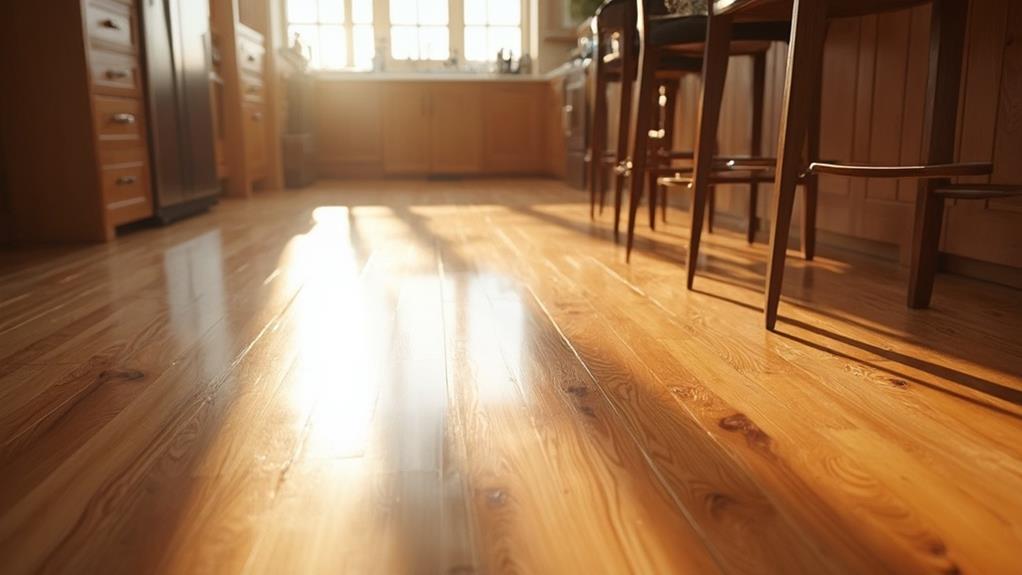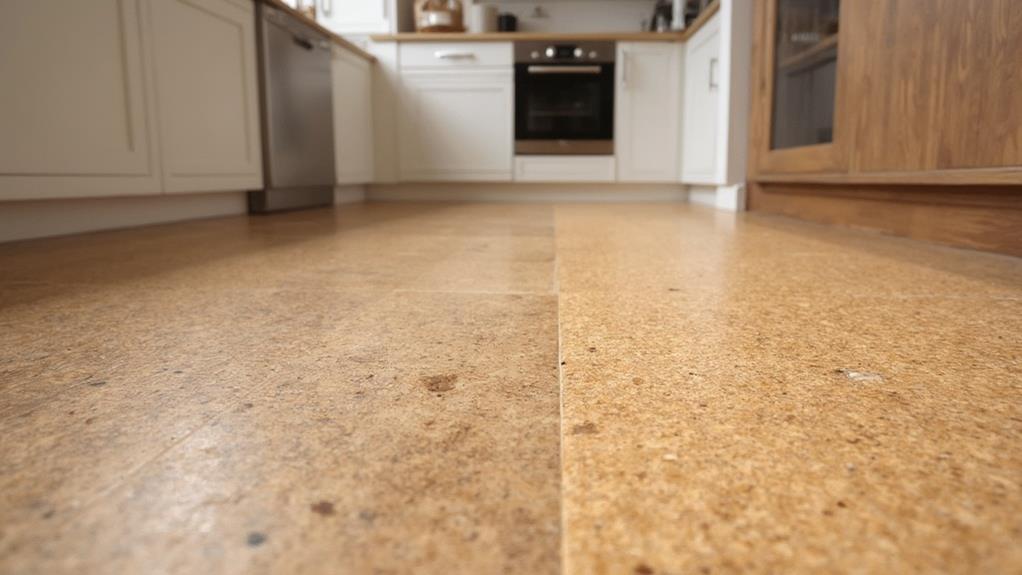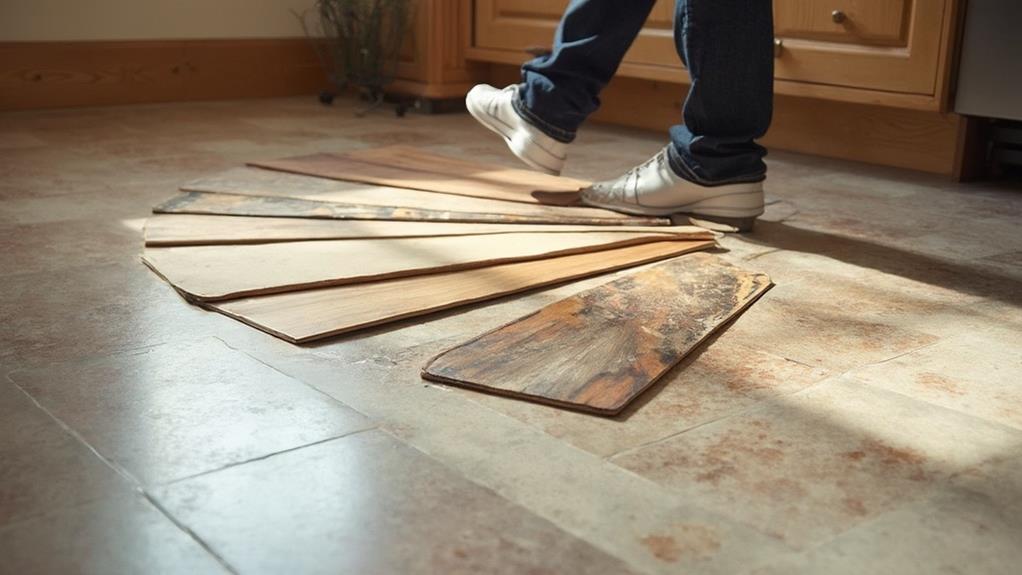When choosing kitchen flooring, you'll find various options with distinct pros and cons. Hardwood offers timeless beauty but can be sensitive to moisture. Ceramic and porcelain tiles are durable and water-resistant but may feel cold underfoot. Luxury vinyl planks provide affordability and easy maintenance, though they lack the authenticity of natural materials. Natural stone exudes elegance but requires more upkeep and comes at a higher cost. Cork flooring is eco-friendly and comfortable but can be prone to damage. Each option has its unique characteristics, and your choice will depend on your specific needs, budget, and style preferences. Exploring these options further will help you make an informed decision for your kitchen.
Hardwood Flooring

Renowned for its timeless appeal, hardwood flooring remains a popular choice for kitchens. It brings warmth and natural beauty to your space, enhancing the overall aesthetic of your home. You'll find a wide variety of wood species, colors, and finishes to match your style and decor.
Hardwood floors are durable and can last for decades with proper care. They're also relatively easy to clean, requiring regular sweeping and occasional mopping. If damaged, you can often sand and refinish hardwood floors, restoring their original beauty.
However, hardwood isn't without its drawbacks in the kitchen. It's susceptible to moisture damage, so you'll need to wipe up spills quickly to prevent warping or staining. The finish can also scratch from heavy foot traffic or dropped utensils. You'll want to use protective pads under appliances and furniture to minimize damage.
Hardwood can be a significant investment upfront, but it often adds value to your home. It's also not the most comfortable flooring to stand on for long periods, so you might consider area rugs in high-traffic zones. Despite these considerations, many homeowners find hardwood's beauty and longevity worth the extra care and cost.
Ceramic and Porcelain Tile
While hardwood offers natural warmth, ceramic and porcelain tile bring durability and water resistance to your kitchen floor. These materials are ideal for high-traffic areas prone to spills and moisture. You'll find a wide range of colors, patterns, and sizes to suit your style preferences.
Ceramic tiles are generally less expensive and easier to cut, making them a popular choice for DIY installations. Porcelain tiles are denser, more durable, and less porous, offering superior stain and moisture resistance.
Both options are easy to clean and maintain, requiring only regular sweeping and occasional mopping. However, tile floors can be cold and hard underfoot, which may be uncomfortable for long periods of standing. They can also be slippery when wet, posing a safety risk.
To address these issues, you can install radiant heating beneath the tiles and use textured surfaces or area rugs for improved traction. Keep in mind that proper installation is crucial to prevent cracking and ensure longevity. Grout lines require periodic sealing to maintain their appearance and prevent staining.
While tiles are durable, they can chip or crack if heavy objects are dropped on them, and repairs can be challenging.
Luxury Vinyl Planks

Luxury vinyl planks (LVP) have revolutionized kitchen flooring options in recent years. These durable, water-resistant planks mimic the look of hardwood while offering enhanced practicality for busy kitchens. You'll find LVP easy to install, often with click-lock systems that allow for DIY installation over existing floors.
One of LVP's biggest advantages is its affordability compared to natural wood or stone. It's also more comfortable underfoot and warmer than tile, making it pleasant for barefoot cooking. Maintenance is a breeze, as you can simply sweep, vacuum, or mop the surface.
However, LVP isn't without drawbacks. While it's resistant to scratches and dents, it can still be damaged by heavy impacts or sharp objects. Some homeowners find that LVP lacks the authentic feel of real wood or stone. Additionally, it may not add as much value to your home as natural materials.
When choosing LVP, look for products with a thick wear layer for better durability. Consider the overall style of your kitchen and select a design that complements your cabinetry and countertops. With proper care, LVP can provide a stylish, practical flooring solution for your kitchen for many years.
Natural Stone Options
Natural stone flooring brings timeless elegance and durability to your kitchen. Options like marble, granite, slate, and travertine offer unique patterns and colors that can elevate your space's aesthetics. Each stone type has its own characteristics, so you'll need to consider your specific needs.
Marble is luxurious but requires regular sealing and can be prone to etching from acidic spills. Granite is incredibly durable and resistant to scratches, making it ideal for high-traffic kitchens. Slate offers a rustic charm and natural slip-resistance, but its layered structure can lead to flaking over time. Travertine has a warm, earthy appearance but is more porous and susceptible to staining.
When choosing natural stone, you'll need to factor in the higher cost compared to other flooring options. Installation is also more complex and typically requires professional expertise. Maintenance is crucial; you'll need to seal the stone periodically and clean up spills promptly to prevent staining. Despite these considerations, natural stone's longevity and unique beauty can make it a worthwhile investment for your kitchen, potentially increasing your home's value.
Cork Flooring

Stepping into the world of eco-friendly flooring, cork offers a unique and sustainable option for your kitchen. This natural material comes from the bark of cork oak trees, which regenerates every nine years, making it a renewable resource. Cork flooring is soft underfoot, providing comfort during long cooking sessions and reducing strain on your joints.
You'll find cork flooring to be naturally resistant to mold, mildew, and insects, making it a hygienic choice for your kitchen. It also has excellent thermal and acoustic insulation properties, helping to keep your kitchen warm and quiet. Cork's natural elasticity means it can bounce back from minor dents and scratches, maintaining its appearance over time.
However, cork isn't without its drawbacks. It's susceptible to fading in direct sunlight and can be damaged by heavy furniture or sharp objects. You'll need to seal it regularly to prevent moisture damage, especially in a kitchen environment. While cork is durable, it may not withstand the heavy foot traffic of busier kitchens as well as some harder flooring options. Consider your lifestyle and kitchen usage when deciding if cork is right for you.
Laminate Flooring
Moving from natural materials to synthetic options, laminate flooring offers a budget-friendly alternative for your kitchen. This versatile flooring consists of multiple layers, including a high-density fiberboard core and a photographic image layer topped with a clear protective coating. You'll find a wide range of designs mimicking wood, stone, or tile, allowing you to achieve the look you want without the high cost.
Laminate's durability is a significant advantage for busy kitchens. It resists scratches, stains, and fading better than many natural materials. You'll also appreciate its easy maintenance; regular sweeping and occasional damp mopping are usually sufficient. Installation is relatively simple, often featuring click-lock systems that don't require adhesives.
However, laminate isn't without drawbacks. It can't be refinished like hardwood, so when it's worn or damaged, you'll need to replace it. While water-resistant options exist, laminate isn't fully waterproof, making it susceptible to moisture damage in high-spill areas. The synthetic nature of laminate means it lacks the warmth and authenticity of natural materials, which may be a concern if you're aiming for a high-end look in your kitchen.
Conclusion
You've now explored various kitchen flooring options, each with its own set of advantages and drawbacks. Remember, "all that glitters is not gold," so don't be swayed by appearance alone. Consider your lifestyle, budget, and maintenance preferences when making your choice. Whether you opt for the classic elegance of hardwood, the durability of tile, or the eco-friendly nature of cork, you'll find a flooring solution that's perfect for your culinary haven.

